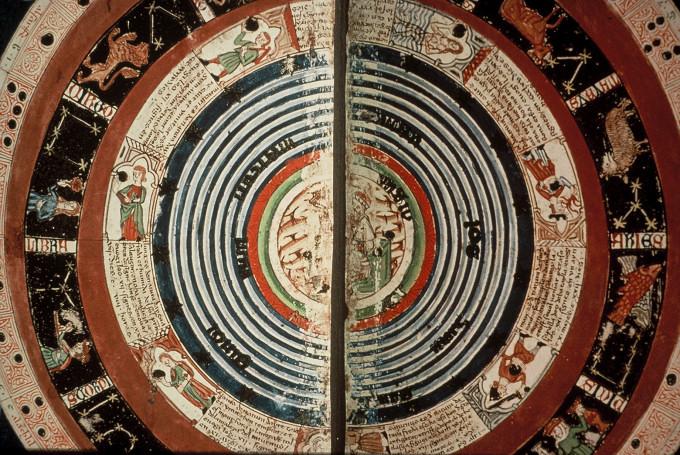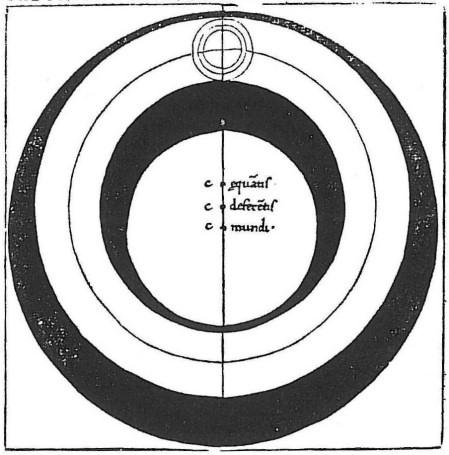The earliest beliefs concerning the construction of the universe come from the myths of Creation and are associated with the deification of celestial bodies.
In the ancient cultures of Egypt and Mesopotamia conceptions of the construction of the universe formed around the 30th century BC were essentially separate from astronomical achievements.
Departure from this way of understanding reality took place in the 6th century BC in ancient Greece. Numerous speculative cosmological theories were formed then that attempted to explain the physical nature of the world and of celestial bodies. The authors of these conceptions who concentrated on finding the arche, the material cause underlying the observed reality, were among others Thales of Miletus (c. 625 BC – c. 547 BC), Anaximander (c. 610 – c. 545 BC), and Pythagoras (c. 572 BC – c. 497 BC). It was the last who probably formed the term cosmos which means the rational order of the universe. And Plato (c. 427 – 374 BC) is believed to have formulated a programme that preserved the spherical model of the cosmos. He probably required that the observed nature of planets should be described with the use of circular and uniform motions. The first consistent solution to this problem was found by Eudoxus of Cnidus (c. 400 BC – c. 347 BC), who constructed a model of the world in the form of concentric spheres. In this model each planet was raised by one or more spheres which revolved at a constant speed around Earth, which always stayed at the same place as their common centre. Spheres rotated around axes which had different poles and were combined with one another and as a result the motion of the outside sphere moved to the inside sphere.
 Manuscript from the 14th century
Manuscript from the 14th century
Eudoxuss model was eventually adopted by Aristotle (384 BC – 322 BC), who developed it even further: the number of spheres increased from the original 26 to 55. Aristotle justified such a construction of the cosmos with the use of the physics of the five elements: in the world under the Moon everything was made of earth, water, air, and fire and was subject to incessant processes of creation and dying. Meanwhile the area starting from the sphere of the Moon and stretching through the spheres of the remaining planets up to the realm of stars was formed by the fifth element, ether, a property of which was an eternal circular uniform motion. Since then, the rationalised spherical universe of Aristotles physics became the cosmological paradigm, which was successfully discarded no sooner than by Copernicus, though attempts to modify Aristotles cosmology had been made earlier.
According to Aristotle the spherical universe enclosed by a rotating sphere of the fixed stars was the whole universe existing for the whole of eternity. Meanwhile, supporters of Plato believed that the universe was created, and the Stoics acknowledged the presence of the space in which the universe was suspended. Atomists assumed that the observed cosmos was an accidental (and passing) system of atoms in an infinite universe, the essence of which was void with indestructible and indivisible particles of matter wandering through the void.
Perhaps the most radical departure from the model of a geocentric cosmos with Aristotles physics was suggested by Aristarchus of Samos (c. 310 BC – 230 BC), who claimed that the observed celestial phenomena may be explained on the basis of the heliocentric system. This proposition, however, did not gain much recognition among natural philosophers. A short extract from a Greek text by Geminos from the first century BC entitled Concise Exposition of the Meteorology of Poseidonios could be a perfect example of the way Aristachuss theory was treated. Geminos writes: And thus a certain person ... says that even if the Earth moves in a certain way and the Sun is in a certain way at rest, the apparent irregularity [of planetary motions] with regard to the Sun can be saved. For it is certainly not for astronomer to know what is by nature at rest and what sort [of bodies] are given to movement. Rather, introducing hypotheses that certain [bodies] are at rest and others are moving, he considers from which hypotheses the phenomena in the heaven will [actually] follow. But he must take from the physicist the first principles, that the motions of the stars are simple, uniform, and orderly, from which he will demonstrate that the dance of all [the stars] is circular... (translated by James Evans and J. Lennart Berggren).
The most sophisticated method of combining mathematical geocentric astronomy with Aristotles universe was developed by Claudius Ptolemy of Alexandria (2nd century BC). In his astronomical work entitled Almagest he presents a complete system of geometrical models, made of circles, large deferents and smaller epicycles that carry the planets. Meanwhile, the physical model of the universe was explained by Ptolemy in his Planetary Hypotheses. In the model described there, each planet moved in a spherical shell, which was thick enough to contain an epicycle, while the lower border of the shell of a planet situated closer to the outside was at the same the upper border of the shell of a planet closer to Earth. Thanks to Ptolemy a long lasting order of planets became established, which was in increasing distance from the Earth: the Moon, Mercury, Venus, the Sun, Mars, Jupiter, and Saturn. However, in order to preserve the accuracy of prediction of planetary motions in his system, Ptolemy introduced some new solutions: the centre of an epicycle moved on the deferent at a constant speed, with respect not to its centre, but to an equant - a point situated as the mirror image of the Earth, on the opposite side of the centre of the deferent and at an equal distance from it. It was a significant departure from the Aristotles theory of motion in the ethereal world.
 Cross-section of the planetary sphere according to Ptolemy's model
Cross-section of the planetary sphere according to Ptolemy's model
In late antiquity knowledge of the universe decreased when compared to the achievements of Ptolemy. In the following centuries there were few works in the West that would directly refer to his treatises. Thanks to a Roman writer Martianus Capella (c. 365–440) a piece of information was preserved that concerned an idea of Heraclides of Pontus (the 4th century BC), who assumed that Mercury and Venus circled the Sun and it was only with it that they rotated around the Earth. Another Roman writer, Macrobius (4th/5th century BC) wrote a commentary on Ciceros Scipios Dream, which contained a popular lecture on cosmology of planetary spheres.
Medieval scholars from Islamic countries and Latin Europe assimilated Ptolemaic astronomy, but at the same time made attempts to restore an ideal concentricity of motions of celestial bodies. Among the authors of the most significant works by Islamic scholars, which contained criticism of the equant in the Ptolemaic system and presented alternative solutions the following names should be mentioned: Ibn al-Haytham (Alhazen; 965 – c. 1040) from Cairo, Muhammad ibn Rushd (Averroës: 1126–1198) from the Moorish Andalusia, Abu Ishaq al-Bitruji (Alpetragius; 12th century) from Andalusia as well, Nasir al-Din al-Tusi (12th century) from Maragheh, and Ibn al-Shatir (14th century) from Damascus.
Revival of the study of the universe in Medieval Western Europe since the 12th century was connected with mastering Arabic translations of Greek authors (including Ptolemy) and of original works by Islamic scholars. Because of that, doubts concerning the relation to reality of mathematical models from the Almagest started to arise among Latin natural philosophers. However, astronomers did not have any alternative theory that would reflect the observed planetary motions better than the models containing an equant. That dilemma revealed itself fully after the publication of Theoricae novae planetarum by Georg Peurbach (1423–1461) in 1474. This work contained not only a summary of Ptolemys astronomy and his Arab critics, but also a detailed description of the Alexandrian astronomers cosmological models in the form of material spheres. Peurbachs textbook was later many times reissued up to the 17th century.
Further reading:
- Astronomy before the telescope, ed. by C. Walker (London, 1996).
- J. Crowe, Theories of the World from Antiquity to the Copernican Revolution (New York, 1990).
- Grant, Planets, Stars, & Orbs: The Medieval Cosmos, 1200–1687 (Cambridge, 1996).
- Pedersen, Early Physics and Astronomy: A Historical Introduction (Cambridge, 1996).
 English (United Kingdom)
English (United Kingdom)  Polski (PL)
Polski (PL) 





